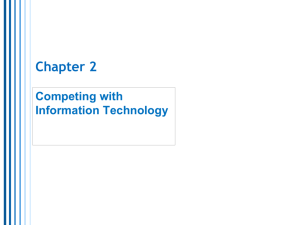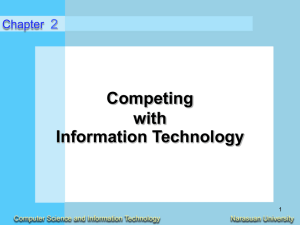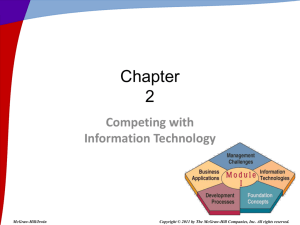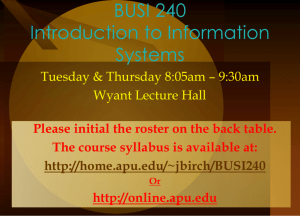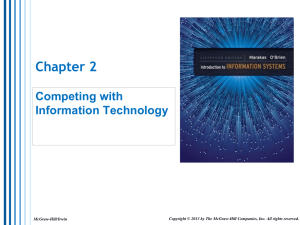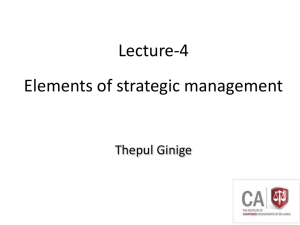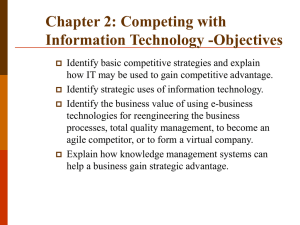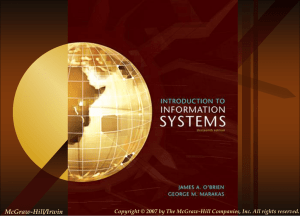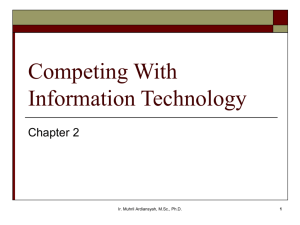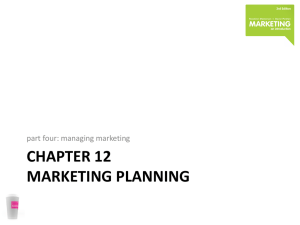Using Information Technology for Strategic Advantage What is
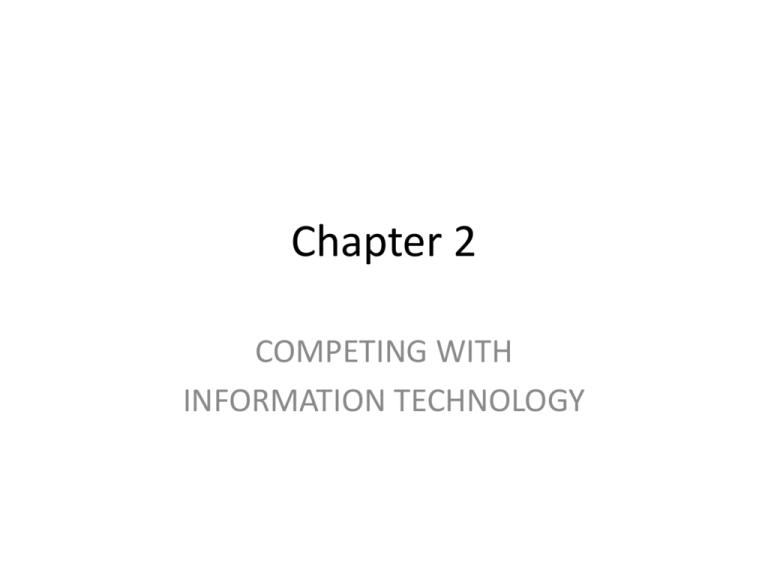
Chapter 2 COMPETING WITH INFORMATION TECHNOLOGY
Objective
• Identify several basic competitive strategies and explain how they use information technologies to confront the competitive forces faced by a business.
• Identify several strategic uses of Internet technologies. • Give examples of how business process reengineering frequently involves the strategic use of Internet technologies.
• Identify the business value of using Internet technologies to become an agile competitor or form a virtual company.
• Explain how knowledge management systems can help a business gain strategic advantages.
Content
• Fundamentals of Strategic Advantage • Using Information Technology for Strategic
Advantage
Fundamentals of Strategic Advantage
• What is competitive strategy? It is a broad-based formula for how a business is going to compete, what its goals should be, and what plans and policies will be required to carry out those goals.
• What is strategic role of information systems? It involves using information technology to develop products, services, and capabilities that give a company major advantages over the competitive forces it faces in the global marketplace. A strategic information system can be any kind of information system (e.g., TPS, MIS, and DSS) that uses information technology to help an organization gain a competitive advantage, reduce a competitive disadvantage, or meet other strategic enterprise objectives.
• Michael Porter’s classic model of competition: – The rivalry of competitors within its industry – The threat of new entrants into an industry and its markets – The threat posed by substitute products that might capture market share – The bargaining power of customers – The bargaining power of suppliers
Fundamentals of Strategic Advantage(Con’t..)
• Competitive Strategies of Michael Porter’s classic model: –
Cost Leadership Strategy
– Differentiation Strategy – Innovation Strategy – Growth Strategies products and services.
– Alliance Strategies companies.
: finding ways to help suppliers or customers reduce their costs or increase the costs of competitors.
: Developing ways to differentiate a firm’s products and services from those of its competitors or reduce the differentiation advantages of competitors.
: Finding new ways of doing business(developing unique products and services or entering unique markets).
: Significantly expanding a company’s capacity to produce goods and services, expanding into global markets, diversifying into new products and services, or integrating into related : Establishing new business linkages and alliances with customers, suppliers, competitors, consultants, and other
Michael Porter’s classic model of competition
Fundamentals of Strategic Advantage(Con’t..)
• How can business managers use investments in information technology to support a firm’s competitive strategies?
Examples of how companies have used information technology to implement five competitive strategies for strategic advantage
Fundamentals of Strategic Advantage(Con’t..)
• There are many strategic initiatives available to a firm in addition to the five basic strategies of cost leadership, differentiation, innovation, growth, and alliance. They include: – Locking in customers or suppliers : Investments in information technology can allow a business to lock in customers and suppliers (and lock out competitors) by building valuable new relationships with them.
– Building switching costs : It emphasis in strategic information systems has been to find ways to create switching costs in the relationships between a firm and its customers or suppliers(It protects customer from change to competitor’s service).
– Raising barriers to entry : discourage or delay other companies from entering a market.
– Leveraging investment in information technology take advantage of opportunities when they arise.
: Investing in information technology enables a firm to build strategic IT capabilities so that they can • Building a Customer Focused Business: The ability to help them keep customers loyal, anticipate their future needs, respond to customer concerns, and provide top-quality customer service(this strategic focus on customer value). Internet technologies can make customers the focal point of customer relationship management (CRM) and other e-business applications.
How a customer-focused business builds customer value and loyalty using Internet technologies
Fundamentals of Strategic Advantage(Con’t..)
• The value chain concept, developed by Michael Porter. It views a firm as a series, chain, or network of basic activities that add value to its products and services and thus add a margin of value to both the firm and its customers. • In the value chain conceptual framework some business activities are :
– Primary processes : are those business activities that are directly related to the manufacture of products or the delivery of services to the customer.
– Support processes : are those business activities that help support the day-to-day operation of the business and that indirectly contribute to the products or services of the organization.
The examples of the variety of strategic information systems that can be applied to a firm’s basic business processes for competitive advantage
Using Information Technology for Strategic Advantage
• How does the organization view IT? If a company emphasized strategic business uses of information technology, its management would view IT as a major competitive differentiator.
• What is business process reengineering (BPR)? It is a fundamental rethinking and radical(large) redesign of business processes to achieve dramatic improvements in cost, quality, speed, and service.
• What is role of Information Technology in reengineering? It plays a major role in reengineering most business processes(Internet technologies can substantially increase
the efficiency of business processes such as communications and collaboration among the people
responsible for their operation and management).
The key ways that business process reengineering differs from business improvement
The order management process consists of several business processes and crosses the boundaries of traditional business functions
Examples of information technologies that support reengineering the order management processes
Using Information Technology for Strategic Advantage
• What is strategy that make company become agile
company?
– The business must ensure that customers perceive the products or services of an agile company as solutions to their individual problems(focus on price products). – An agile company cooperates with customers, suppliers, other companies, and even with its competitors(It allows a business
to bring products to market as rapidly and cost-effectively as
possible).
– An agile company organizes so that it thrives on change and uncertainty. It uses flexible organizational structures keyed to
the requirements of different and constantly changing
customer opportunities.
– An agile company leverages the impact of its people and the knowledge they possess. An agile company provides powerful
incentives for employee responsibility, adaptability, and
innovation.
How information technology can help a company be an agile competitor
Using Information Technology for Strategic Advantage
• What is Virtual company(virtual corporation or
virtual organization)? It is an organization that
uses information technology to link people, organizations, assets, and ideas.
• Why do people form virtual companies?
– Share infrastructure and risk with alliance partners.
– Link complementary core competencies.
– Reduce concept-to-cash time through sharing.
– Increase facilities and market coverage.
– Gain access to new markets and share market or customer loyalty.
– Migrate from selling products to selling solutions.
A virtual company uses the Internet, intranets, and extranets to form virtual workgroups and support alliances with business partners
Using Information Technology for Strategic Advantage
• What does knowledge that company use to create company? Many companies today can only realize lasting competitive advantage if they become knowledge-creating companies or learning organizations.
• Knowledge-creating companies exploit two kinds of knowledge: – Explicit knowledge – Tacit knowledge , which is the data, documents, and things written down or stored on computers.
, or the “how-tos” of knowledge, which resides in workers.
• Why does Knowledge Management System become major strategies? Many companies are building knowledge management systems (KMS) to manage organizational learning and business know-how. The goal of such systems is to help knowledge workers create, organize, and make available important business knowledge, wherever and whenever it’s needed in an organization.
Knowledge management can be viewed as three levels of techniques, technologies, and systems that promote the collection, organization, access, sharing, and use of workplace and enterprise knowledge
